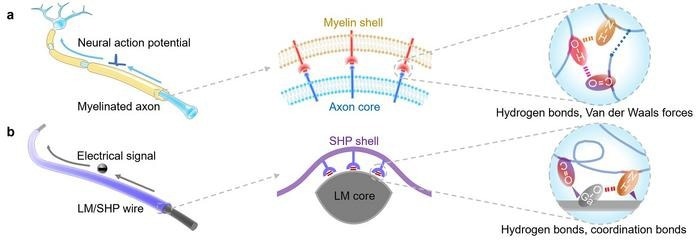Highly conductive and flexible wires are essential for the application and integration of wearable technology. However, these wires are susceptible to structural damage from the regular stress and deformation that comes with practical use, which might result in the collapse of the module as a whole. When faced with structural damage, self-healable wires can restore their mechanical and electrical characteristics, providing a potentially effective resolution to the previously described problem.
 (a) Schematic illustration of the core-shell configuration of the myelinated axon with efficient neural action potential transmission capability. The hydrogen bonds and Van der Waals forces between the myelin shell and axon core guarantee reliable transmission of neural action potential in myelinated axon. (b) Schematic illustration of self-healable wires (LM/SHP) with high dynamic stability and sufficient electron transport capability. The hydrogen-bond and coordination-bond interactions between the self-healable polymer (SHP) shell and liquid metal (LM) core result in mechanical-electrical coupling for enhancement of the dynamic stability. Image Credit: Science China Press
(a) Schematic illustration of the core-shell configuration of the myelinated axon with efficient neural action potential transmission capability. The hydrogen bonds and Van der Waals forces between the myelin shell and axon core guarantee reliable transmission of neural action potential in myelinated axon. (b) Schematic illustration of self-healable wires (LM/SHP) with high dynamic stability and sufficient electron transport capability. The hydrogen-bond and coordination-bond interactions between the self-healable polymer (SHP) shell and liquid metal (LM) core result in mechanical-electrical coupling for enhancement of the dynamic stability. Image Credit: Science China Press
However, under dynamic conditions like bending, pressing, stretching, and tremoring, the highly fluctuating electrical resistance of self-healable wires hinders their practical applications. It significantly reduces the accuracy of continuous monitoring of interconnected wearable devices.
To address these bottlenecks, a research team led by Prof. Hao Sun from Shanghai Jiao Tong University created a novel family of dynamically stable self-healable wires based on mechanical-electrical coupling, motivated by the hydrogen bonds and van der Waals forces interaction between the axon core and myelin shell in myelinated axons.
They used supramolecular chemistry to increase the tensile strength (35-73 MPa) of the self-healable wires, comparable to conventional textile fibers (28-74 MPa). Furthermore, the mechanical-electrical coupling effect based on hydrogen and coordination bonds between the structural (self-healable polymer) and conductive (GaInSn liquid metal) components significantly improved the electrical stability of the self-healable wires in a variety of dynamic environments.
For example, the resistance change of these self-healable wires was less than 0.7 ohms at a 500% strain, and the electrical resistance increased by less than 5% under various dynamic situations such as bending, pressing, knotting, and washing.
These wires’ superior mechanical, electrical, and dynamic qualities make them promising for wearable applications. An integrated healthcare platform, for example, could be constructed with temperature, pulse, and K+ sensors, a microcontroller unit, a Bluetooth module, and a lithium-ion battery.
These components would all be connected by means of these self-healing wires, which, even after breaking and healing, demonstrated a negligible electrical resistance fluctuation of 3-4% under hammering, pressing, and stretching.
Furthermore, it enabled consistent and reliable monitoring of human actions even in the presence of limb tremors generated by simulated Parkinson’s disease. These findings demonstrated the need for excellent dynamic stability in self-healable wires to ensure the reliable functioning of interconnected wearable devices.
We need self-healable wires that can maintain their electrical resistance under dynamic conditions, which is key to ensuring the precision and reliability of the interconnected wearable devices in practical applications. In our attempts to achieve this goal, we notice that the nervous system can reliably transmit neural action potentials even under severe deformations, which inspires us to propose the ‘mechanical-electrical coupling’ mechanism, focusing on enhancement of interfacial interaction.
Hao Sun, Professor, Shanghai Jiao Tong University
Sun added, “We therefore innovate self-healable polymer materials via supramolecular chemistry to induce strong interaction with GaInSn liquid metal, thus achieving dynamically stable self-healable wires that benefit practical wearable scenarios. In a broader perspective, our ‘mechanical-electrical coupling’ can become a general strategy to improve the dynamic stability of various flexible materials and devices, and benefit a variety of applications such as wearable healthcare, intelligent robotics, and implantable electronics.”
Journal Reference:
Wang, S., et. al. (2024) A dynamically stable self-healable wire based on mechanical–electrical coupling. National Science Review. doi:10.1093/nsr/nwae006